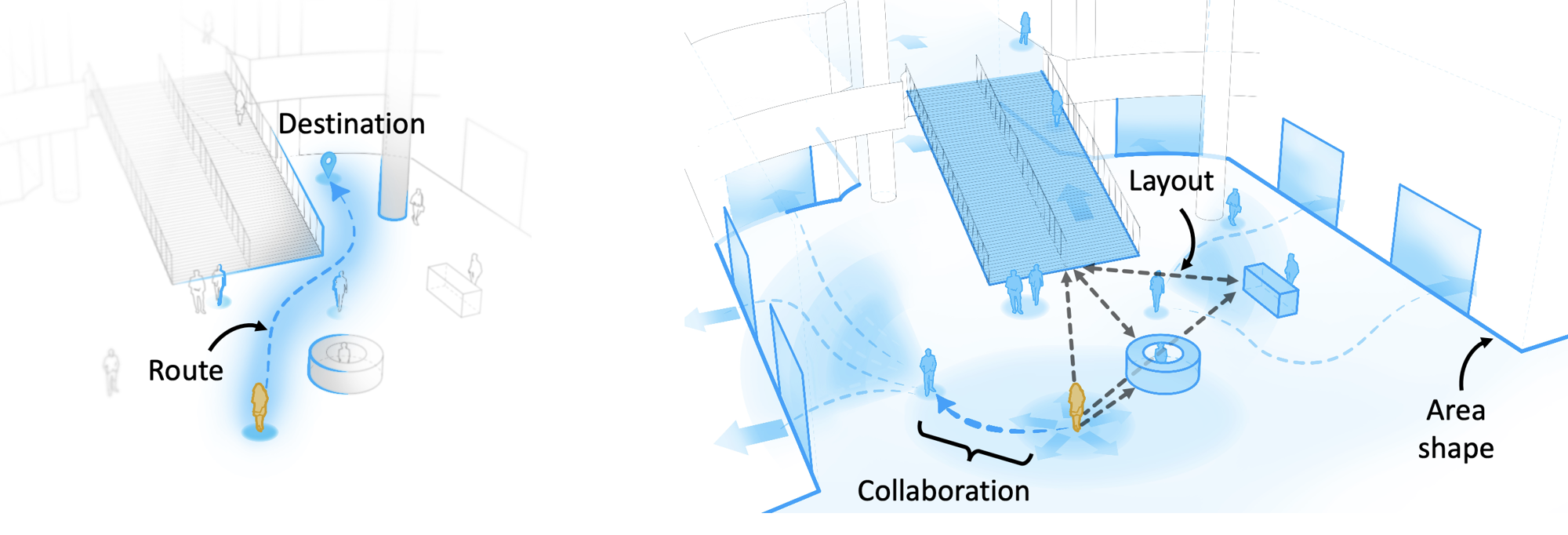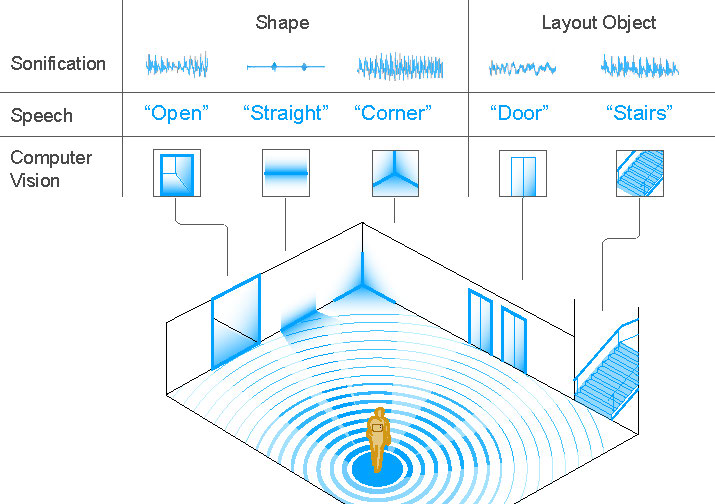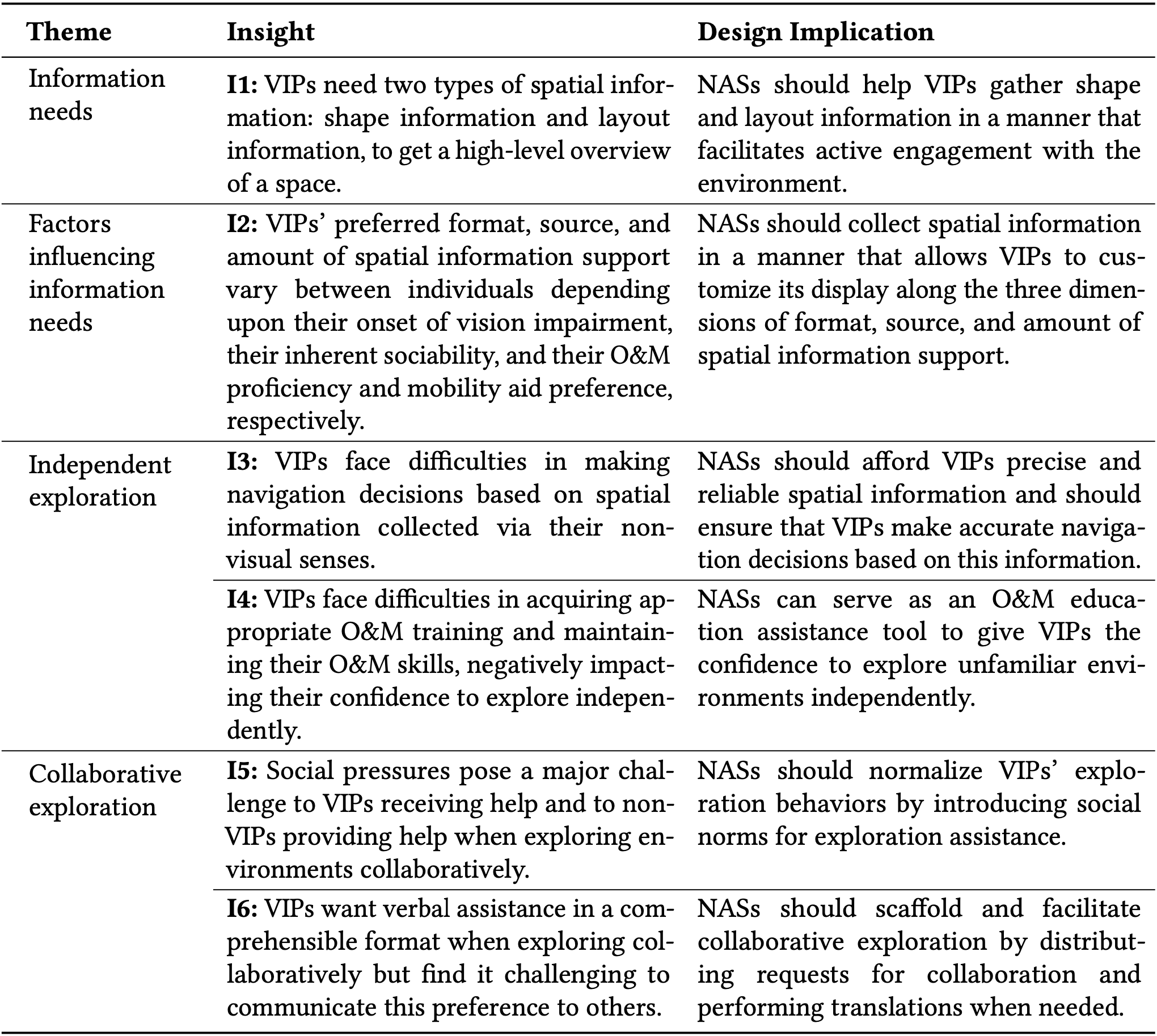"I Want to Figure Things Out"
Supporting exploration in navigation for people with visual impairments
"I Want to Figure Thing Out" is a research paper winning Impact Recognition Award at CSCW2023 on technology-mediated spatial navigation.
In this work, I had the privilege of significantly shaping the research conceptualization and design implications, leading the user study and qualitative analysis, writing the original drafts, and creating visualizations.
I draw insights from interdisciplinary synthesis (architecture, neuroscience, observations, and interviews) to frame research gaps focusing on the freedom to explore unfamiliar physical spaces.
The initial project goal was to use a shortest path algorithm combined with computer vision to provide conventional turn-by-turn directions for blind and low-vision individuals.
Leading the formative user study, I observed firsthand the frustrations of blind and low-vision users with rigid directions, and through interviews, I learned their unique practices of exploring with non-visual senses.
This desire for more freedom resonated with my architectural experience -- the joy and liberty of looking around and wandering through a new place.
Simultaneously, I was reading M.R. O'Connor's book Wayfinding: The Science and Mystery of How Humans Navigate the World, which discussed the importance of spatial exploration to human brain health, contributing to humanity's development as we migrate to build homes in new environments.
Conceptualizing these ideas together, I proposed a new strategic angle and reshaped the research on flexible exploration.
Additionally, I outlined a spatial information hierarchy based on shapes and layouts.
The impact of my contributions is uniquely influenced by my background in architecture and spatial design. It continues to serve as a profound source of inspiration for my future research endeavors.

Our study investigates how navigation assistance should evolve to support blind people in exploring unfamiliar environments. Traditional approaches, as shown on the left, focus solely on guiding users to their destination. Our findings, as shown on the right, reveal that navigation systems can support exploration in three ways: by conveying area shapes, by conveying the layout of objects, and by facilitating effective collaboration with other people (both blind and sighted), who can "unlock" additional avenues of exploration for the user.
Navigation assistance systems (NASs) aim to help visually impaired people (VIPs) navigate unfamiliar environments. Most of today's NASs support VIPs via turn-by-turn navigation, but a growing body of work highlights the importance of exploration as well. It is unclear, however, how NASs should be designed to help VIPs explore unfamiliar environments.
In this work, we aim to establish a holistic understanding of how NASs can be designed to support exploration. Specifically, we investigate the following two research questions:
RQ1. What information do VIPs need to explore unfamiliar environments, and what factors influence these needs between individuals?
RQ2. What challenges do VIPs face while exploring unfamiliar environments, both independently and collaboratively?
RQ1 Findings: VIPs' Information Needs for Exploration
Our interviews with VIPs revealed that they need two types of spatial information for exploration:
Shape Information -- a skeletal wire-frame of the environment that marks its bounds and provides a high-level overview.
Layout Information -- arrangement of different objects within the space; both with respect to the user (egocentric) and with respect to the environment (allocentric).
We also identified three factors that influence individuals’ preferences for spatial information: (1) the stage of life in which they became visually impaired, (2) their inherent sociability, and (3) their O&M proficiency and mobility aid preference. These factors were found to influence individual preferences for the format, source, and amount of spatial information needed during exploration.
For example, regarding the preferred format of spatial information, late-blind VIPs—that is, VIPs who became visually impaired later in life—prefer receiving spatial information as descriptions with as much visual detail as possible. Early-blind VIPs, on the other hand, prefer receiving spatial information as confirmations, supplementing information they gathered via their non-visual senses such as hearing, touch, and smell.

RQ2 Findings: VIPs' Challenges in Exploration
Our analysis revealed several challenges that VIPs face during exploration, which we present around two major means of exploration, (1) independent exploration: exploring by themselves, and (2) collaborative exploration: exploring by seeking assistance from others.
Regarding VIPs' challenges in independent exploration, we found that VIPs hesitate to explore environments by themselves because of their lack of confidence in acting upon spatial information collected via non-visual senses such as hearing, touch, and smell. Moreover, even when reliable spatial information is available, VIPs still do not feel they can explore environments independently because their self reported O&M proficiency falls short.
Regarding VIPs' challenges in collaborative exploration, both VIPs and their collaborators reported that social pressure on the person helping the VIP is a major obstacle to their successful collaboration. For example, our interview with a grocery store employee revealed their concerns about invading a visually impaired customer's privacy and bodily autonomy despite their best intentions of helping the customer. In addition, we learned that VIPs find it difficult to supervise and comprehend assistance from their collaborators. For example, sighted collaborators describe shape information via visual concepts such as letters—describing a hallway as "U-shaped," for instance—which is difficult for VIPs to comprehend.



